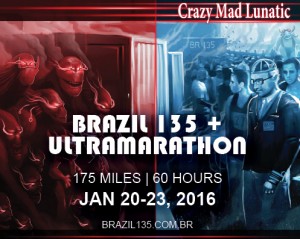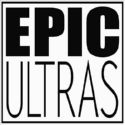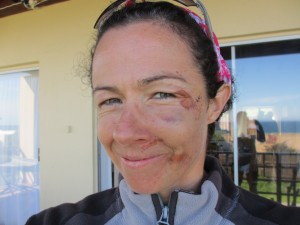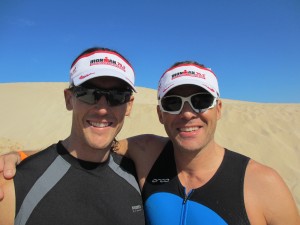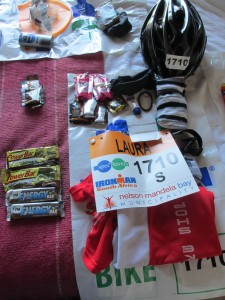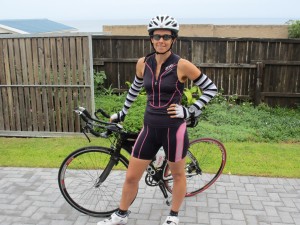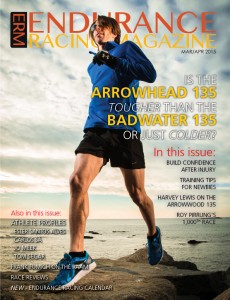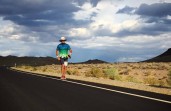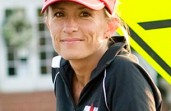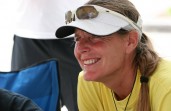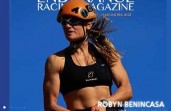British athlete, Laura Watson, gives a wonderful account of her second Ironman. Through pre-race crashes to a potential cancellation and swimming through freezing waters, Watson persevered.
Ironman South Africa
By Laura Watson
Crashing was not part of the pre-race week plan.
I had been training for Ironman South Africa, my second Ironman. Five days before the race, my two buddies and I were out for a short spin along the race course just to freshen up our legs. The edge of the road was rough, and the Tarmac lip led onto gravel. We were almost back to our rented house when Nick, riding just ahead of me, slipped off the edge of the road onto the gravel. He tried to recover, but his front wheel couldn’t make the step up; he fell sideways, sliding across the road in front of me. With no time to stop or go around him, I ploughed straight over the top of him, somehow riding over his back before coming off in turn. My knees, shoulder and head hit the road, breaking my sunglasses on impact. We both lay stunned in the middle of the quiet road for a moment before managing to drag ourselves onto the verge with our bikes. Cordell had been a bit behind and escaped unscathed. Nick briefly lost consciousness. I just felt dazed – then the first thoughts crowded in: “Oh shit, what about the Ironman, what about the bike?” Luckily, Nick had his phone and we called for help. Sore and bleeding from our road rash, but remarkably not seriously injured, we managed to pile the bikes into our rescue van and get home.
For both of us, it was our first-ever big wipeout on a bike – and five days before an Ironman. Nick had blown a tire and wrecked his helmet strap, and had nasty road rash on his hands, knee and shoulder. My bike was scratched and my helmet cracked. I had road rash on both knees, my shoulder and the whole of the left side of my face, and a small but deep cut on my temple and a burgeoning headache.
Instead of the planned wetsuit trial in the sea that afternoon, the rest of the day was spent cleaning and dressing wounds, and getting two stitches to my face. We both felt exhausted and a bit discouraged by another obstacle in the way of completing an Ironman; but, hey, you don’t do an Ironman because it’s easy, and we had been lucky no one had been seriously hurt and the bikes were intact.
Nick and I felt bruised, sore and tired the next day. We tried a short 30-minute jog, although every step hurt and my head still pounded. Imagining having to run a marathon under these conditions seemed unbearable.
Three days before race day, we did a sprint tri. We painfully got into our wetsuits, which pulled and rubbed against our raw shoulders and knees. The ocean was cold, but crystal clear. Out past the breakers we swam a short way, bumping into a couple of huge jelly fish. Each of us found a transcendental moment in that swim, enjoying the swells and the clarity of the water, and feeling the excitement that was an impending Ironman. Getting out of the wetsuit, however, was no less painful as we moved to our bikes. Our confidence was still shaken; but while we felt nervous on the bikes, we had a good ride and transitioned to our short run.
Nick was becoming obsessed with the weather forecast. Gale-force westerly winds were predicted, with rain and a big sea swell. Apparently Port Elizabeth Bay is somewhat sheltered, but there is always the risk of cancellation if the waves get too high. I was in denial of the weather, still hoping for a calm and clear day; Cordell was just trying to get over his transatlantic jet lag and his head cold; and Mike was reading the weather reports.
By Friday, our wounds were drying up and beginning to heal. I still looked like I had gone a couple of rounds in a fight, and with Nick’s gouged knuckles it looked like it might have come from him. My headache was mostly settled, and we had all bikes and gear in working order again. Our excitement was building. We took quiet time to visualize the course, the transitions and a strong finish. We had done the work, which included months of hard training, lonely long bike rides, hot long runs, boring pool laps and careful nutrition, and now it was all about to come together.
The pre-race pasta party was held in a huge tent just off the sea front, with plenty of emphasis on the corporate sponsors and an inspiring video clip of the previous year’s race. Race Director Paul Wolfe had us clutching each other in horror when he confirmed the dire weather forecast and told us what the arrangements would be should he need to cut or cancel part of the race. “But I will let you ride in the wind, though,” he said. “Windy is okay.” Imagine all that work and then the race is cancelled – it really didn’t bear thinking about.
After the pasta party we picked up Joe, who was coming in from Dar es Salaam. Finally, our support team was complete. The next day, Saturday, we packed our race bags, made final bike checks and checked in our bags at the race venue. It was hard to leave the bikes outside on the transition rack and the race bags on their hooks overnight, knowing the next time we would see them it would be on race day.
With nothing left to do except rest, eat and obsess just a little over last-minute minor details – like how many gels will fit into the bento box on the bike, which warm layer for the run (or not), what the strategy plan for the bike portion would be if the forecasted winds appeared – we rested and chatted and tried to distract each other. As the sun went down, we watched the waves get bigger and the weather front roll in from the ocean as the wind speeds increased.
The night was short and restless and I was awake before the 3:30 a.m. alarm anyway, so I covered myself in body glide and, breaking the no-new-things-on-race-day rule, slipped into my new Orca trisuit. Joe helped me cover all my wounds with dressings, figuring that this would at least delay the pain from friction from the wetsuit. I felt calm. I knew I had put in the hours, I knew I could do it – it was just a question of how fast I could go. My goal was fairly simple: just finish. Ironman is an epic day and a really tough endeavour; you just don’t know what the day will throw at you, and the first objective has to be to get to the line within 17 hours. The night before, I had read the excellent advice to “check your ego in with your swim bag at transition” – and it’s true. Ironman is a humbling experience, and it’s best not to forget that.
Next, my goal was to enjoy the day. With all the support I had had along the way from family and friends, the least I could do was have fun. I secretly wanted to do better than the past year in New Zealand. A 12:30 finish would be fantastic – half an hour quicker than last year. I knew I was as fit and definitely a stronger cyclist, and had no major injuries to contend with. I was ready.
We walked to transition in the rain and said goodbye to our supporters. It was cold, and a bit rainy and windy. After final bike checks, I was already cold and wet. When I changed into my wetsuit I became more chilled, but it felt better to be in the wetsuit. After checking in the swim bags, we headed down to the warm-up area on the beach to “warm up” in the water – or in my case, to get colder. The sea was fairly calm, so we weren’t too worried; but the wind chilled us, and we huddled under an overhang of the sea wall trying to get warm for a while. Once we were called down to the beach starting area, we spent 20 minutes in the wind; I got colder and colder, and Cordell and I both started to shiver. A few people had double caps on, which was smart; those wearing shortie or sleeveless wetsuits looked half frozen.
Nick, Cordell and I hugged each other and wished each other good luck. The African dancers on the beach stopped, and a silence descended on the beach. I closed my eyes and lifted my face to the rain to listen to the uplifting South African national anthem, “N’kosikele Africa”. The cannon fired, and we were off.
I got into swimming as soon as I could, trying to swim hard for a few minutes to pick up a draft, staying in relatively clear water, and trying to warm up. The sea state was okay to the first buoy, and I kept my goggles on and maintained a reasonable stroke. The sheer momentum of so many people rounding the buoy created a current, so even though we all bobbed along in a crush, we were carried round the buoy and could start swimming again. Past the pier, the chop started. A rough surface made it almost impossible to see. I swallowed sea water and just tried to keep going, with no choice but to follow the crowd and hope they were all going the right way. Halfway to the second buoy my calf cramped, making it impossible to kick; but the buoyancy of the wetsuit and some good bubbles to follow meant that I could keep going and was doing alright. The cramps settled, but were replaced by the nagging feeling that I wasn’t warming up; in fact, my hands were getting colder. I was shivering a little, but kept it going and got back to the last buoy in about 45 minutes. Slower than I’d hoped, but I had made it.
 At this point I started to feel really cold. My hands lost feeling, and I could no longer close the fingers of my right hand to make a scoop to pull through the water. I swallowed more and more sea water. All I could think was, “Just keep going, keep breathing, keep kicking.” My arm muscles started to get cold and not work so well. I felt like I was swimming with claw hands, or fists, and was making slow progress. I shivered and began to wonder if I was going to make it, and then, if it was safe to continue. I could see the canoes lining the course, and by the second to last buoy I was thinking about looking for a canoe and getting out of the water. I felt really hideous; I was freezing, and a little afraid. I dug deep and found a conviction that I did not want my race to end like this. I did all those long training rides, and what, now I was not even going to make it onto the bike? It can’t be that way.
At this point I started to feel really cold. My hands lost feeling, and I could no longer close the fingers of my right hand to make a scoop to pull through the water. I swallowed more and more sea water. All I could think was, “Just keep going, keep breathing, keep kicking.” My arm muscles started to get cold and not work so well. I felt like I was swimming with claw hands, or fists, and was making slow progress. I shivered and began to wonder if I was going to make it, and then, if it was safe to continue. I could see the canoes lining the course, and by the second to last buoy I was thinking about looking for a canoe and getting out of the water. I felt really hideous; I was freezing, and a little afraid. I dug deep and found a conviction that I did not want my race to end like this. I did all those long training rides, and what, now I was not even going to make it onto the bike? It can’t be that way.
I am not sure how I made the last few hundred meters. I felt like my arms and hands were useless; and with the current pushing me back and the seriously choppy surface, maybe I just got lucky on a draft. The sounds of music from the beach and the knowledge that it would soon end pulled me home – as well as the fear of the huge disappointment that would have accompanied an early DNF. Almost 60 athletes were not so lucky, with half being pulled out of the water onto canoes and half missing the 2:20 cutoff time.
I got out of the water feeling terrible. I was shivering uncontrollably and unable to feel my fingers or my feet as I stumbled up the beach and into the transition tent. I was totally unable to take off my wetsuit, and was dependent on a lovely volunteer who helped me. Even my face muscles were frozen; about all I could manage to say was, “Shirt, shirt.” I fumbled on the dry bike shirt that I thankfully had left in my bike bag. I looked around the tent and saw that everyone was shivering. One woman staggered out of the tent into the arms of a volunteer; it was clear she wasn’t going anywhere. Somehow I got on the arm warmers and gloves and socks and shoes, and filled my pockets with bananas and gels. I was still shivering hard and feeling nauseous from all the salt water, but I found my bike and got going. I got a small boost from the fact that I wasn’t one of the last ones in transition as usual. It looked like everyone had had a hard time in the water, and there were still a lot of bikes on the rack.
As I cycled along Marine Drive, I desperately needed to warm up. Pretty soon the road turned west, starting the long, slow 14 k climb up the ironically named Mt. Pleasant. That took me straight into a 60-kph headwind, so it was very slow going. The effort began to warm me up, though, and I had a moment of joy that I had made it through the toughest swim of my life. Everyone was crawling up this hill. My Garmin watch had discharged all the charge overnight for some reason, so I had no heart rate monitor and just my bike speedometer. For the next 45 to 60 minutes, it read the slowest speeds it’s ever recorded. I was barely able to get above 11 or 12 kph on the inclines, maybe 17-20 on the flats into the wind. It was brutal; I was cycling in the lowest gear, and at times standing on the pedals to avoid falling over. The after-effects of the swim weren’t over yet, either; my stomach was cramping badly, probably from all water I had swallowed. Agonizing belly cramps meant I couldn’t get onto the aero bars and would need a pit stop at the first portaloos. I kept my mind busy, working out which trees would be good to pee behind if needed, trying not to draft anyone and trying not to fall off. There was no hope of spinning the legs easy; it was a hard climb and I could feel the muscle strain. There was also no hope of eating or drinking anything during this stage of the race.
By the top of the hill I had warmed up, though my feet were still numb. A pit stop allowed a brief rest, and opportunity to take off the billowy bike shirt and stuff it down the back of my bike shorts. The next 15 km to the turnaround were still into the headwind, but not so uphill and much more manageable. I drank some water, ate a banana and found my mojo coming back. I began to believe in the race again. Seeing Nick racing down the other side of the road with the wind at his back and a cheery shout and wave cheered me up immensely, and soon I too had reached the magical turnaround point. The instant the bike swung around, the wind stopped being my enemy and became my friend. I cycled along at an easy 40 kph, and felt great and as I stuffed down some PowerBars and drank lots of water. Soon I came to the turnoff onto a road perpendicular with the wind. The side gusts were incredible. I slowed down; for all I could do was grip hold of the side bars as hard as I could and try to keep control of the bike. Terrifying gusts of wind blasted us sideways, pushing me at times from the edge of the road to the central white line. After a time, the descent from Mt. Pleasant back to town was with the wind behind me; I was going super fast and I loved it.
Checking the time at the end of my first lap, I mentally reset all my goals. It had been almost a two-hour swim including transition, 90 minutes to go the first 30 k of the bike, total lap time around 2:20, I estimated. I would be lucky to be close to seven hours, and it might be eight once I got tired.
Port Elizabeth, however, was humming. Hundreds of people had braved the awful weather and were blowing vuvuzelas and playing music and cheering. I scanned people along the route for our friends. I got a wave of intense emotion when I couldn’t see them, for I desperately didn’t want to miss them. Then suddenly there they were, shouting and going crazy. What an incredible boost! It’s silly, perhaps; but when it’s hard out there, to feel the love like that is wonderful.
Then it was onto the second lap. Knowing what to expect this time, I settled in for another long, slow, hard slog up that hill into the headwind. Still with a few stomach cramps, but I had been following my plan of eating every half-hour and it was digesting okay, and I had taken in a lot of water. I told myself all the way round, “Next time you see this will be the last time…” I kept revising my time goals. My feet were still numb, and my knee hurt the whole way, just the skin; and with this and the need to absolutely concentrate in order to not fall off from the wind, the time went quite fast. The reward of speeding down Marine Drive was great.
The third lap, if anything, felt even better. The stomach cramps had gone, I was warm, and I managed a better speed on the incline and overtook a lot of tired cyclists. A few people were even walking up the hill, pushing their bikes. It felt like the wind had dropped a little, and the gusty sections weren’t so bad. I started looking forward to the run, wondering how cold it would be. I had left my special needs bag with run shirt in it in my wardrobe by accident that morning, and so had no warm clothes if it got cold. It would just have to be okay. I wondered how my legs would feel after so much effort against the wind. I avoided thinking about running a marathon and instead concentrated on thinking about running a 10 k four times – which sounds altogether easier. Pretty soon I was past our friends, making a noise and handing off my bike to a volunteer. T2 was much easier than T1. The sun was shining, the bike was over, and I know I am a solid runner.
The first 7 k wasn’t too hard. Soon, however, my legs were tight, my feet numb, and there was a pain in my right ankle; after a while, I was just lumbering along. “Short stride,” I told myself. “Concentrate on form, enjoy the crowds.” I walked a little on an incline, but that was the last time I needed to walk (outside an aid station) for the rest of the run. A short, very heavy, sharp and cold rain squall started, and at the start of the third lap I tripped on a tiny speed bump, falling flat on my face and re-gouging out the holes in my knee and elbow. I lay on the ground for a moment, thinking, “Oh for feck’s sake, this day is insane” – but then a passing racer reached down a hand and got me to my feet. I trotted on, blood on my leg again. The volunteers and supporters and our friends were amazing, and I moved forward.
Five km until I can get back to the music and lights of the town. Four km until I can see my friends again. Two km to my next Coca-Cola fix.
The third lap was great. I had saved energy and I used it, powering past literally hundreds of people, some running, some walking. I picked groups of people in front of me and reeled them in, passing them with strength. I knew my friends and hot soup awaited me, that I would finish, that I would cross the line and hear that cry of “You are an IRONMAN!” Coming into the bend leading to the red carpet and the finish Shute was a fantastic feeling. With a big smile on my face I crossed the line, and there was Mike, waiting with a hug and a giant grin.
“The others are at least half an hour behind you,” he said. “They are really struggling on the run.” I wanted to see them finish, but I was hurting and beginning to get cold. I craved hot soup. I fitted in a quick visit to the massage tent, where it felt amazing to be able to lie down and painful to have somebody rub my calves. I wrapped up in the space blanket but was still cold. I had been cold the whole day. Nick crossed the line, and not long after, Cordell. We had all made it, on a day so hard that 18% failed to finish.
Cordell soon felt rough, his hips cramping up and in pain; Nick’s intercostal muscles (muscles in between the ribs) seized up and he felt like he couldn’t breathe – so we spent the next hour in the medical tent. Our friends kicked into action, stripping off clothing to cover us up even though they had been out in the cold all day, too, and found blankets and more space blankets. In a damp fleece, a rain jacket, two heavy blankets and two space blankets, and with three cups of soup and two hot cups of sweet tea, I finally began to feel warmer.
Unable to face the rain and winds to gather our stuff, we felt incredibly grateful for Joe, Tamara and Mike, who collected bikes, bags and finisher shirts and helped us make the short walk to the car. We were too tired and cold for champagne; it was 1:30 a.m. before we finally hit our beds, achy and tired but somehow wired, too – three worn-out Ironmen. It had been a brutally hard day, with what were reportedly the toughest weather conditions they’d ever had. There were no PBs, but we’d all made it, and all showed grit and determination – humbled by the weather and the kindness of volunteers.
http://www.resultri.com/races/ironman-south-africa-2012/1710-Laura-Watson


